- GCN/BACODINE POSITION NOTICE
TITLE: GCN/SWIFT NOTICE
NOTICE_DATE: Fri 12 May 06 23:26:32 UT
NOTICE_TYPE: Swift-BAT GRB Position
TRIGGER_NUM: 209755, Seg_Num: 0
GRB_RA: 195.772d {+13h 03m 05s} (J2000),
195.845d {+13h 03m 23s} (current),
195.197d {+13h 00m 47s} (1950)
GRB_DEC: +41.212d {+41d 12' 43"} (J2000),
+41.178d {+41d 10' 40"} (current),
+41.480d {+41d 28' 49"} (1950)
GRB_ERROR: 3.00 [arcmin radius, statistical only]
GRB_INTEN: 18561 [cnts] Image_Peak=437 [image_cnts]
TRIGGER_DUR: 4.096 [sec]
TRIGGER_INDEX: 290 E_range: 15-50 keV
BKG_INTEN: 167591 [cnts]
BKG_TIME: 83542.81 SOD {23:12:22.81} UT
BKG_DUR: 40 [sec]
GRB_DATE: 13867 TJD; 132 DOY; 06/05/12
GRB_TIME: 83600.73 SOD {23:13:20.73} UT
GRB_PHI: 148.64 [deg]
GRB_THETA: 35.40 [deg]
SOLN_STATUS: 0x3
RATE_SIGNIF: 11.66 [sigma]
IMAGE_SIGNIF: 9.39 [sigma]
MERIT_PARAMS: +1 +0 +0 +3 +1 +1 +0 +0 +38 +1
SUN_POSTN: 49.67d {+03h 18m 41s} +18.29d {+18d 17' 21"}
SUN_DIST: 112.77 [deg] Sun_angle= -9.7 [hr] (East of Sun)
MOON_POSTN: 225.00d {+15h 00m 01s} -20.75d {-20d 45' 03"}
MOON_DIST: 67.58 [deg]
MOON_ILLUM: 100 [%]
GAL_COORDS: 114.02, 75.71 [deg] galactic lon,lat of the burst (or transient)
ECL_COORDS: 174.13, 43.30 [deg] ecliptic lon,lat of the burst (or transient)
COMMENTS: SWIFT-BAT GRB Coordinates.
COMMENTS: This Notice was delayed by more than 30 sec past the end of the trigger integration interval;
COMMENTS: probably due to it occurring during a Malindi downlink session.
COMMENTS: This is a rate trigger.
COMMENTS: A point_source was found.
COMMENTS: This does not match any source in the on-board catalog.
COMMENTS: This does not match any source in the ground catalog.
COMMENTS: This is a GRB.
COMMENTS: This trigger occurred at longitude,latitude = 12.71,-0.82 [deg].
- red DSS finding chart
ps-file
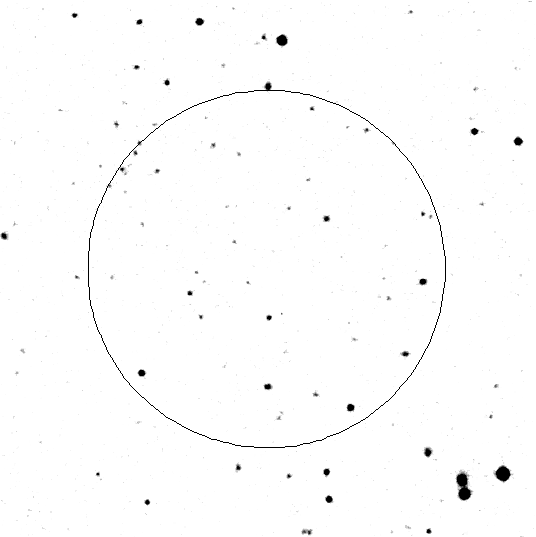
- GCN NOTICE
TITLE: GCN/SWIFT NOTICE
NOTICE_DATE: Fri 12 May 06 23:27:18 UT
NOTICE_TYPE: Swift-XRT Image
TRIGGER_NUM: 209755, Seg_Num: 0
GRB_RA: 195.7745d {+13h 03m 05.8s} (J2000),
195.8476d {+13h 03m 23.4s} (current),
195.1993d {+13h 00m 47.8s} (1950)
GRB_DEC: +41.1918d {+41d 11' 30.4"} (J2000),
+41.1577d {+41d 09' 27.8"} (current),
+41.4601d {+41d 27' 36.3"} (1950)
GRB_ERROR: 7.6 [arcsec, radius, statistical plus systematic]
GRB_INTEN: 25 [cnts]
IMG_START_DATE: 13867 TJD; 132 DOY; 06/05/12
IMG_START_TIME: 83702.50 SOD {23:15:02.50} UT, 101.8 [sec] since BAT Trigger Time
CENTROID_X: 359.36, raw= 359 [pixels]
CENTROID_Y: 314.99, raw= 315 [pixels]
ROLL: 324.94 [deg]
GAIN: 1
MODE: 3, Long Image mode
WAVEFORM: 134
EXPO_TIME: 2.50 [sec]
GRB_POS_XRT_Y: 38.16
GRB_POS_XRT_Z: 136.86
IMAGE_URL: sw00209755000msxps_rw.img
SUN_POSTN: 49.67d {+03h 18m 41s} +18.29d {+18d 17' 21"}
SUN_DIST: 112.79 [deg] Sun_angle= -9.7 [hr] (East of Sun)
MOON_POSTN: 225.01d {+15h 00m 02s} -20.75d {-20d 45' 11"}
MOON_DIST: 67.57 [deg]
MOON_ILLUM: 100 [%]
GAL_COORDS: 114.00, 75.73 [deg] galactic lon,lat of the burst
ECL_COORDS: 174.14, 43.28 [deg] ecliptic lon,lat of the burst
COMMENTS: SWIFT-XRT Image.

- GCN NOTICE
TITLE: GCN/SWIFT NOTICE
NOTICE_DATE: Fri 12 May 06 23:27:16 UT
NOTICE_TYPE: Swift-XRT Position
TRIGGER_NUM: 209755, Seg_Num: 0
GRB_RA: 195.7745d {+13h 03m 05.8s} (J2000),
195.8476d {+13h 03m 23.4s} (current),
195.1993d {+13h 00m 47.8s} (1950)
GRB_DEC: +41.1918d {+41d 11' 30.4"} (J2000),
+41.1577d {+41d 09' 27.8"} (current),
+41.4601d {+41d 27' 36.3"} (1950)
GRB_ERROR: 7.6 [arcsec radius, statistical plus systematic, 90% containment]
GRB_INTEN: 2.60e-10 [erg/cm2/sec]
GRB_SIGNIF: 5.00 [sigma]
IMG_START_DATE: 13867 TJD; 132 DOY; 06/05/12
IMG_START_TIME: 83702.50 SOD {23:15:02.50} UT, 101.8 [sec] since BAT Trigger Time
TAM[0-3]: 327.63 237.14 261.26 243.23
AMPLIFIER: 2
WAVEFORM: 134
SUN_POSTN: 49.67d {+03h 18m 41s} +18.29d {+18d 17' 21"}
SUN_DIST: 112.79 [deg] Sun_angle= -9.7 [hr] (East of Sun)
MOON_POSTN: 225.01d {+15h 00m 02s} -20.75d {-20d 45' 11"}
MOON_DIST: 67.57 [deg]
MOON_ILLUM: 100 [%]
GAL_COORDS: 114.00, 75.73 [deg] galactic lon,lat of the burst
ECL_COORDS: 174.14, 43.28 [deg] ecliptic lon,lat of the burst
COMMENTS: SWIFT-XRT Coordinates.
- GCN NOTICE
TITLE: GCN/SWIFT NOTICE
NOTICE_DATE: Fri 12 May 06 23:30:14 UT
NOTICE_TYPE: Swift-UVOT Source List
TRIGGER_NUM: 209755, Seg_Num: 0
POINT_RA: 195.757d {+13h 03m 02s} (J2000)
POINT_DEC: +41.228d {+41d 13' 43"} (J2000)
POINT_ROLL: 324.935d
IMG_START_DATE: 13867 TJD; 132 DOY; 06/05/12
IMG_START_TIME: 83711.12 SOD {23:15:11.12} UT, 110.4 [sec] since BAT Trigger Time
FILTER: 10, White
BKG_MEAN: 1.068
N_STARS: 13
X_OFFSET: 328 [pixels]
Y_OFFSET: 616 [pixels]
X_MAX: 1287 [pixels]
Y_MAX: 1575 [pixels]
DET_THRESH: 9
PHOTO_THRESH: 4
SL_URL: sw00209755000msufc0110.fits
SUN_POSTN: 49.67d {+03h 18m 42s} +18.29d {+18d 17' 23"}
SUN_DIST: 112.75 [deg] Sun_angle= -9.7 [hr] (East of Sun)
MOON_POSTN: 225.04d {+15h 00m 09s} -20.76d {-20d 45' 43"}
MOON_DIST: 67.62 [deg]
MOON_ILLUM: 100 [%]
GAL_COORDS: 114.08, 75.70 [deg] galactic lon,lat of the pointing direction
ECL_COORDS: 174.10, 43.31 [deg] ecliptic lon,lat of the pointing direction
COMMENTS: SWIFT-UVOT Source List.
- GCN NOTICE
TITLE: GCN/SWIFT NOTICE
NOTICE_DATE: Fri 12 May 06 23:30:54 UT
NOTICE_TYPE: Swift-UVOT Image
TRIGGER_NUM: 209755, Seg_Num: 0
POINT_RA: 195.757d {+13h 03m 02s} (J2000)
POINT_DEC: +41.228d {+41d 13' 43"} (J2000)
ROLL: 324.935d
IMG_START_DATE: 13867 TJD; 132 DOY; 06/05/12
IMG_START_TIME: 83711.12 SOD {23:15:11.12} UT, 110.4 [sec] since BAT Trigger Time
FILTER: 10, White
EXPOSURE_ID: 169168512
X_OFFSET: 504 [pixels]
Y_OFFSET: 933 [pixels]
WIDTH: 160 [pixels]
HEIGHT: 160 [pixels]
X_GRB_POS: 664
Y_GRB_POS: 1093
BINNING_INDEX: 1
IM_URL: sw00209755000msuni0110.fits
SUN_POSTN: 49.68d {+03h 18m 42s} +18.29d {+18d 17' 23"}
SUN_DIST: 112.75 [deg] Sun_angle= -9.7 [hr] (East of Sun)
MOON_POSTN: 225.04d {+15h 00m 10s} -20.76d {-20d 45' 51"}
MOON_DIST: 67.63 [deg]
MOON_ILLUM: 100 [%]
GAL_COORDS: 114.08, 75.70 [deg] galactic lon,lat of the pointing direction
ECL_COORDS: 174.10, 43.31 [deg] ecliptic lon,lat of the pointing direction
COMMENTS: SWIFT-UVOT Image.
COMMENTS: The GRB Position came from the XRT Position Command.
COMMENTS: The image has 2x2 binning (compression).
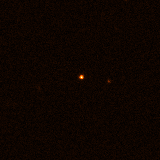
- GCN NOTICE
TITLE: GCN/SWIFT NOTICE
NOTICE_DATE: Fri 12 May 06 23:29:47 UT
NOTICE_TYPE: Swift-BAT GRB Lightcurve
TRIGGER_NUM: 209755, Seg_Num: 0
GRB_RA: 195.772d {+13h 03m 05s} (J2000),
195.845d {+13h 03m 23s} (current),
195.197d {+13h 00m 47s} (1950)
GRB_DEC: +41.212d {+41d 12' 43"} (J2000),
+41.178d {+41d 10' 40"} (current),
+41.480d {+41d 28' 49"} (1950)
GRB_DATE: 13867 TJD; 132 DOY; 06/05/12
GRB_TIME: 83600.73 SOD {23:13:20.73} UT
TRIGGER_INDEX: 290
GRB_PHI: 148.64 [deg]
GRB_THETA: 35.40 [deg]
DELTA_TIME: -31.00 [sec]
TRIGGER_DUR: 4.096 [sec]
SOLN_STATUS: 0x3
RATE_SIGNIF: 11.66 [sigma]
IMAGE_SIGNIF: 9.39 [sigma]
LC_URL: sw00209755000msb.lc
SUN_POSTN: 49.67d {+03h 18m 42s} +18.29d {+18d 17' 23"}
SUN_DIST: 112.77 [deg] Sun_angle= -9.7 [hr] (East of Sun)
MOON_POSTN: 225.03d {+15h 00m 08s} -20.76d {-20d 45' 39"}
MOON_DIST: 67.60 [deg]
MOON_ILLUM: 100 [%]
GAL_COORDS: 114.02, 75.71 [deg] galactic lon,lat of the burst (or transient)
ECL_COORDS: 174.13, 43.30 [deg] ecliptic lon,lat of the burst (or transient)
COMMENTS: SWIFT-BAT GRB Lightcurve.
COMMENTS:
COMMENTS: The next comments were copied from the BAT_POS Notice:
COMMENTS: This is a rate trigger.
COMMENTS: A point_source was found.
COMMENTS: This does not match any source in the on-board catalog.
COMMENTS: This does not match any source in the ground catalog.
COMMENTS: This is a GRB.
COMMENTS: This trigger occurred at longitude,latitude = 12.71,-0.82 [deg].
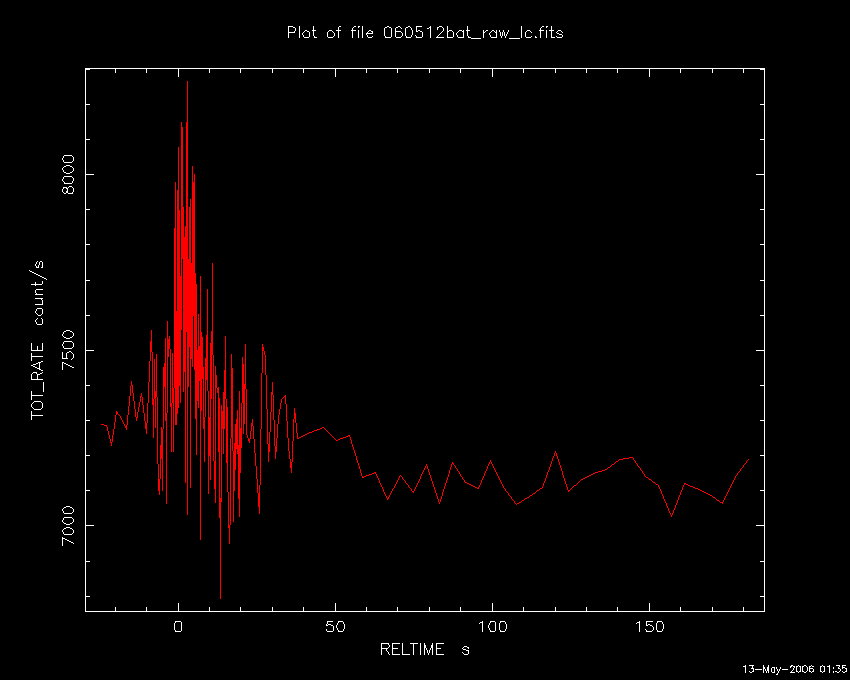
- GCN NOTICE
TITLE: GCN/SWIFT NOTICE
NOTICE_DATE: Fri 12 May 06 23:27:50 UT
NOTICE_TYPE: Swift-XRT Processed Image
TRIGGER_NUM: 209755, Seg_Num: 0
GRB_RA: 195.7745d {+13h 03m 05.8s} (J2000),
195.8476d {+13h 03m 23.4s} (current),
195.1993d {+13h 00m 47.8s} (1950)
GRB_DEC: +41.1918d {+41d 11' 30.4"} (J2000),
+41.1577d {+41d 09' 27.8"} (current),
+41.4601d {+41d 27' 36.3"} (1950)
GRB_ERROR: 7.6 [arcsec, radius, statistical plus systematic]
GRB_INTEN: 25 [cnts]
IMG_START_DATE: 13867 TJD; 132 DOY; 06/05/12
IMG_START_TIME: 83702.50 SOD {23:15:02.50} UT, 101.8 [sec] since BAT Trigger Time
CENTROID_X: 359.36, raw= 359 [pixels]
CENTROID_Y: 314.99, raw= 315 [pixels]
ROLL: 324.94 [deg]
GAIN: 1
MODE: 3, Long Image mode
WAVEFORM: 134
EXPO_TIME: 2.50 [sec]
GRB_POS_XRT_Y: 38.16
GRB_POS_XRT_Z: 136.86
IMAGE_URL: sw00209755000msxps_rw.img
SUN_POSTN: 49.67d {+03h 18m 42s} +18.29d {+18d 17' 21"}
SUN_DIST: 112.79 [deg] Sun_angle= -9.7 [hr] (East of Sun)
MOON_POSTN: 225.01d {+15h 00m 04s} -20.76d {-20d 45' 17"}
MOON_DIST: 67.57 [deg]
MOON_ILLUM: 100 [%]
GAL_COORDS: 114.00, 75.73 [deg] galactic lon,lat of the burst
ECL_COORDS: 174.14, 43.28 [deg] ecliptic lon,lat of the burst
COMMENTS: SWIFT-XRT Processed Image.

- GCN NOTICE
TITLE: GCN/SWIFT NOTICE
NOTICE_DATE: Fri 12 May 06 23:33:00 UT
NOTICE_TYPE: Swift-UVOT Processed Source List
TRIGGER_NUM: 209755, Seg_Num: 0
POINT_RA: 195.757d {+13h 03m 02s} (J2000)
POINT_DEC: +41.228d {+41d 13' 43"} (J2000)
POINT_ROLL: 324.935d
IMG_START_DATE: 13867 TJD; 132 DOY; 06/05/12
IMG_START_TIME: 83711.12 SOD {23:15:11.12} UT, 110.4 [sec] since BAT Trigger Time
FILTER: 10, White
BKG_MEAN: 1.068
N_STARS: 13
X_OFFSET: 328 [pixels]
Y_OFFSET: 616 [pixels]
X_MAX: 1287 [pixels]
Y_MAX: 1575 [pixels]
DET_THRESH: 9
PHOTO_THRESH: 4
SL_URL: sw00209755000msufc0110.fits
SUN_POSTN: 49.68d {+03h 18m 42s} +18.29d {+18d 17' 25"}
SUN_DIST: 112.75 [deg] Sun_angle= -9.7 [hr] (East of Sun)
MOON_POSTN: 225.06d {+15h 00m 15s} -20.77d {-20d 46' 14"}
MOON_DIST: 67.64 [deg]
MOON_ILLUM: 100 [%]
GAL_COORDS: 114.08, 75.70 [deg] galactic lon,lat of the pointing direction
ECL_COORDS: 174.10, 43.31 [deg] ecliptic lon,lat of the pointing direction
COMMENTS: SWIFT-UVOT Processed Source List.
COMMENTS: All 4 attachments are included.
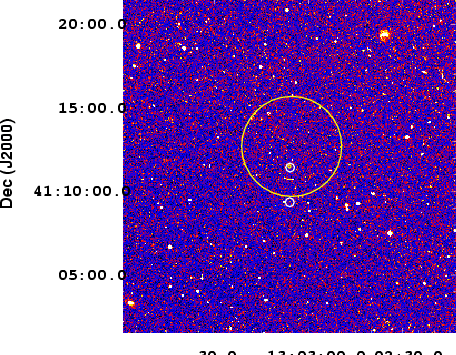
- GCN NOTICE
TITLE: GCN/SWIFT NOTICE
NOTICE_DATE: Fri 12 May 06 23:34:50 UT
NOTICE_TYPE: Swift-UVOT Processed Image
TRIGGER_NUM: 209755, Seg_Num: 0
POINT_RA: 195.757d {+13h 03m 02s} (J2000)
POINT_DEC: +41.228d {+41d 13' 43"} (J2000)
ROLL: 324.935d
IMG_START_DATE: 13867 TJD; 132 DOY; 06/05/12
IMG_START_TIME: 83711.12 SOD {23:15:11.12} UT, 110.4 [sec] since BAT Trigger Time
FILTER: 10, White
EXPOSURE_ID: 169168512
X_OFFSET: 504 [pixels]
Y_OFFSET: 933 [pixels]
WIDTH: 160 [pixels]
HEIGHT: 160 [pixels]
X_GRB_POS: 664
Y_GRB_POS: 1093
BINNING_INDEX: 1
IM_URL: sw00209755000msuni0110.fits
SUN_POSTN: 49.68d {+03h 18m 43s} +18.29d {+18d 17' 26"}
SUN_DIST: 112.75 [deg] Sun_angle= -9.7 [hr] (East of Sun)
MOON_POSTN: 225.08d {+15h 00m 19s} -20.78d {-20d 46' 34"}
MOON_DIST: 67.65 [deg]
MOON_ILLUM: 100 [%]
GAL_COORDS: 114.08, 75.70 [deg] galactic lon,lat of the pointing direction
ECL_COORDS: 174.10, 43.31 [deg] ecliptic lon,lat of the pointing direction
COMMENTS: SWIFT-UVOT Processed Image.
COMMENTS: The GRB Position came from the XRT Position Command.
COMMENTS: The image has 2x2 binning (compression).
COMMENTS: If you have elected to receive attachments:
COMMENTS: The uvot_catalog_image.fits.gz file does not exist; skipping the attachment.
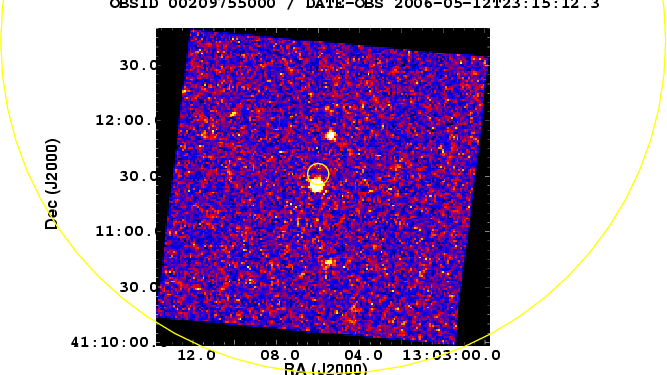
- GCN NOTICE
TITLE: GCN/SWIFT NOTICE
NOTICE_DATE: Fri 12 May 06 23:35:30 UT
NOTICE_TYPE: Swift-UVOT Source List
TRIGGER_NUM: 209755, Seg_Num: 0
POINT_RA: 195.758d {+13h 03m 02s} (J2000)
POINT_DEC: +41.231d {+41d 13' 52"} (J2000)
POINT_ROLL: 324.936d
IMG_START_DATE: 13867 TJD; 132 DOY; 06/05/12
IMG_START_TIME: 83816.42 SOD {23:16:56.42} UT, 215.7 [sec] since BAT Trigger Time
FILTER: 3, V
BKG_MEAN: 0.654
N_STARS: 9
X_OFFSET: 184 [pixels]
Y_OFFSET: 613 [pixels]
X_MAX: 1143 [pixels]
Y_MAX: 1572 [pixels]
DET_THRESH: 7
PHOTO_THRESH: 3
SL_URL: sw00209755000msufc0215.fits
SUN_POSTN: 49.68d {+03h 18m 43s} +18.29d {+18d 17' 26"}
SUN_DIST: 112.75 [deg] Sun_angle= -9.7 [hr] (East of Sun)
MOON_POSTN: 225.08d {+15h 00m 20s} -20.78d {-20d 46' 41"}
MOON_DIST: 67.66 [deg]
MOON_ILLUM: 100 [%]
GAL_COORDS: 114.08, 75.70 [deg] galactic lon,lat of the pointing direction
ECL_COORDS: 174.10, 43.31 [deg] ecliptic lon,lat of the pointing direction
COMMENTS: SWIFT-UVOT Source List.
- GCN NOTICE
TITLE: GCN/SWIFT NOTICE
NOTICE_DATE: Fri 12 May 06 23:37:21 UT
NOTICE_TYPE: Swift-UVOT Processed Source List
TRIGGER_NUM: 209755, Seg_Num: 0
POINT_RA: 195.758d {+13h 03m 02s} (J2000)
POINT_DEC: +41.231d {+41d 13' 52"} (J2000)
POINT_ROLL: 324.936d
IMG_START_DATE: 13867 TJD; 132 DOY; 06/05/12
IMG_START_TIME: 83816.42 SOD {23:16:56.42} UT, 215.7 [sec] since BAT Trigger Time
FILTER: 3, V
BKG_MEAN: 0.654
N_STARS: 9
X_OFFSET: 184 [pixels]
Y_OFFSET: 613 [pixels]
X_MAX: 1143 [pixels]
Y_MAX: 1572 [pixels]
DET_THRESH: 7
PHOTO_THRESH: 3
SL_URL: sw00209755000msufc0215.fits
SUN_POSTN: 49.68d {+03h 18m 43s} +18.29d {+18d 17' 27"}
SUN_DIST: 112.75 [deg] Sun_angle= -9.7 [hr] (East of Sun)
MOON_POSTN: 225.10d {+15h 00m 24s} -20.78d {-20d 47' 02"}
MOON_DIST: 67.67 [deg]
MOON_ILLUM: 100 [%]
GAL_COORDS: 114.08, 75.70 [deg] galactic lon,lat of the pointing direction
ECL_COORDS: 174.10, 43.31 [deg] ecliptic lon,lat of the pointing direction
COMMENTS: SWIFT-UVOT Processed Source List.
COMMENTS: All 4 attachments are included.
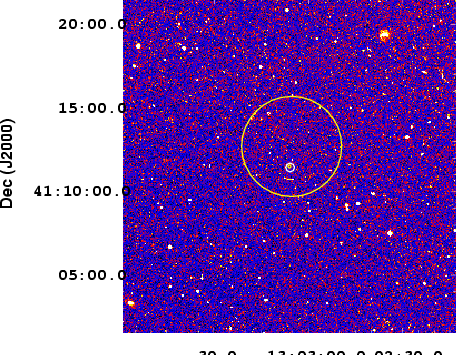
- GCN Circular #5117
J. R. Cummings (NASA/ORAU), M. M. Chester (PSU),
N. Gehrels (NASA/GSFC), O. Godet (U Leicester),
H. A. Krimm (GSFC/USRA), K. L. Page (U Leicester),
D. M. Palmer (LANL) and M. Stamatikos (NASA/GSFC/ORAU) report on
behalf of the Swift Team:
At 23:13:20 UT, the Swift Burst Alert Telescope (BAT) triggered and
located GRB 060512 (trigger=209755). Swift slewed immediately to the burst.
The BAT on-board calculated location is
RA,Dec 195.772, +41.212 {13h 03m 05s, +41d 12' 43"} (J2000)
with an uncertainty of 3 arcmin (radius, 90% containment, including
systematic uncertainty). The BAT light curve showed a single peak
with a duration of about 20 sec. The peak count rate
was ~500 counts/sec (15-350 keV), at ~3 sec after the trigger.
The XRT began observing the field at 23:15:02 UT, 102 seconds after the
BAT trigger. XRT found a bright, uncatalogued X-ray source
located at RA(J2000) = 13h 03m 05.8s, Dec(J2000) = +41d 11' 30.4", with an
estimated uncertainty of 7.6 arcseconds (90% confidence radius).
This location is 73 arcseconds from the BAT on-board position, within
the BAT error circle. The initial flux in the 2.5s image was
2.6e-10 erg/cm2/s (0.2-10 keV).
UVOT took a finding chart exposure of 100 seconds with the White
(160-650 nm) filter starting 112 seconds after the BAT trigger. There
is a candidate afterglow in the rapidly available 2.7'x2.7' sub-image
at (RA,DEC) (J2000) of (195.7742,41.1909) or
(13h03m05.81s,+41o11'27.2") with a 1-sigma error radius of about 0.5
arc sec. This position is 3.2 arc sec. from the center of the XRT
error circle. The estimated magnitude is 16.2 with a 1-sigma error of
about 0.5 mag. No correction has been made for the expected extinction
corresponding to E(B-V) of 0.02.
- GCN Circular #5119
C.G. Mundell and I.A. Steele report on behalf of the Liverpool GRB group:
"The 2-m Liverpool Telescope followed up GRB060513
(SWIFT trigger 209755) approximately 20 min after the GRB trigger time.
We confirm the UVOT identification of a fading OT (Cummings et al GCN 5117)
at: 13:03:05.8 +41:11:26.8 +\- 0.5 arcsec (J2000)
with magnitude r' = 18.2 +/- 0.3 mag (vs USNOB1) at 46 min.
Observations and analysis are ongoing.
This message may be cited"
- GCN Circular #5119
C.G. Mundell and I.A. Steele report on behalf of the Liverpool GRB group:
"We incorrectly named GRB 060512 as 060513; we apologize for the
mistake and reiterate:
The 2-m Liverpool Telescope followed up GRB060512 (SWIFT trigger 209755)
approximately 20 min after the GRB trigger time. We confirm the UVOT
identification of a fading OT (Cummings et al GCN 5117)
at: 13:03:05.8 +41:11:26.8 +\- 0.5 arcsec (J2000)
with magnitude r' = 18.2 +/- 0.3 mag (vs USNOB1) at 46 min.
Observations and analysis are ongoing.
This message may be cited"
- GCN Circular #5120
Richard J. Cool (Arizona), Daniel J. Eisenstein (Arizona),
David W. Hogg (NYU), Michael R. Blanton (NYU), David
J. Schlegel (LBNL), J. Brinkmann (APO), Donald Q. Lamb
(Chicago), Donald P. Schneider (PSU), and Daniel E. Vanden
Berk (PSU) report:
The Sloan Digital Sky Survey (SDSS) imaged the field of
burst GRB060512 prior to the burst. As these data should
be useful as a pre-burst comparison and for calibrating
photometry, we are supplying the images and photometry
measurements for this GRB field to the community.
Data from the SDSS, including 5 FITS images, 3 JPGS, and
3 files of photometry and astrometry, are being placed
at http://mizar.as.arizona.edu/~grb/public/GRB060512
We supply FITS images in each of the 5 SDSS bands of a
8'x8' region centered on the GRB position (ra=195.775
(13:03:05.9), dec=41.1918 (41:11:30.5); GCN 5117),
as well as 3 gri color-composite JPGs (with different
stretches). The units in the FITS images are nanomaggies
per pixel. A pixel is 0.396 arcsec on a side. A nanomaggie
is a flux-density unit equal to 10^-9 of a magnitude
0 source or, to the extent that SDSS is an AB system,
3.631e-6 Jy. The FITS images have WCS astrometric
information.
In the file GRB060512_sdss.calstar.dat, we report
photometry and astrometry of 268 bright stars (r<20.5)
within 15' of the burst location. The magnitudes presented
in this file are asinh magnitudes as are standard in the
SDSS (Lupton 1999, AJ, 118, 1406). Beware that some of
these stars are not well-detected in the u-band; use the
errors and object flags to monitor data quality.
In the files GRB060512_sdss.objects_flux.dat and
GRB060512_sdss.objects_magnitudes.dat, we report photometry
of 466 objects detected within 6' of the GRB position.
We have removed saturated objects and objects with
model magnitudes fainter than 23.0 in the r-band.
The fluxes listed in GRB060512_sdss.objects_flux.dat
are in nanomaggies while the magnitudes listed in
GRB060512_sdss.objects_magnitudes.dat are asinh magnitudes.
**Be aware that at least a portion of the photometry
provided in this release has been flagged as
non-photometric. As photometry for
objects with this flag
set may have non-optimal calibration, we do not recommend
these objects be used for photometric calibration.
Non-photometric imaging may still be valuable as a
pre-burst comparison and for astrometric calibration.
All quantities reported are standard SDSS photometry,
meaning that they are very close to AB zeropoints
and magnitudes are quoted in asinh magnitudes.
Photometric zeropoints are known to about 2% rms.
None of the photometry is corrected for dust extinction.
The Schlegel, Finkbeiner, and Davis (1998) predictions
for this region are A_U=0.087 mag, A_g=0.064 mag, A_r =
0.047 mag, A_i=0.035 mag, and A_z=0.025 mag.
The file GRB060512_sdss.spectro.dat contains a list of
the 2 objects with SDSS spectroscopy within 6 arcminutes
of the GRB position. In addition to the redshift and
1-sigma error for each object, this file also lists the
object spectroscopic classification.
SDSS astrometry is generally better than 0.1 arcsecond
per coordinate. Users requiring high precision astrometry
should take note that the SDSS astrometric system can
differ from other systems such as those used in other
notices; we have not checked the offsets in this region.
More detailed information pertaining to our SDSS GRB
releases can be found in our initial data release paper
(Cool et al. 2006, astro-ph/0601218). See the SDSS DR4
documentation for more details: http://www.sdss.org/dr4.
These data have been reduced using a slightly different
pipeline than that used for SDSS public data releases.
We cannot guarantee that the values here will exactly match
those in the data release in which these data are included.
In particular, we expect the photometric calibrations to
differ by of order 0.01 mag.
This note may be cited, but please also cite the SDSS data
release paper, Adelman-McCarthy et al. (2006, ApJS, in
press, astro-ph/0507711), when using the data or referring
to the technical documentation.
- GCN Circular #5121
S. Covino, D. Malesani, P. D'Avanzo, E. Molinari, G. Chincarini, F.M.
Zerbi, V. Testa, G. Tosti, F. Vitali, P. Conconi, G. Cutispoto, G.
Malaspina, L. Nicastro, E. Palazzi, E. Meurs, and P. Goldoni report on
behalf of the REM/ROSS team:
We imaged the field of GRB 060512 (Cummings et al., GCN 5117) with the
robotic 60-cm REM telescope located at La Silla (Chile). Observations
were performed automatically in the near infrared (J, H, K, z bands)
starting 62 s after the GCN alert (almost 14 minutes after the GRB).
The first observations were performed at about airmass 6.8, under
difficult conditions.
Preliminary analysis of the dataset does not show any new source down to
approximately H = 15.2 at the position of the optical afterglow reported
by Cummings et al. (GCN 5117) and Mundell et al. (GCNs 5118, 5119).
Further observations and analysis are still in progress.
This message is citeable.
- GCN Circular #5122
D. Malesani (SISSA), S. Piranomonte (INAF-OAR), S. Covino (INAF/OABr),
N. Masetti, E. Maiorano (INAF/IASF Bo), A. Magazzu', G. Mainella
(INAF/TNG), report on behalf of a larger collaboration:
We observed the optical afterglow of GRB 060512 (Cummings et al., GCN
5117) with the 3.6 TNG telescope located in the Canary Islands. Two
R-band observations were acquired under good observing conditions, with
mean times May 13.018 and May 13.065 UT (1.2 and 2.3 hr after the GRB,
respectively). The optical afterglow (Cummings et al., GCN 5117; Mundell
& Steele, GCN 5118) is well detected and faded by 0.58 +- 0.04 mag
between the two epocs. The inferred decay index is alpha = 0.81 +- 0.06,
assuming a flux decay F(t) = K*t^-alpha.
We acknowledge significant support from the observing staff at TNG.
This message can be cited.
- GCN Circular #5124
J. Cummings (GSFC/ORAU), S. Barthelmy (GSFC), L. Barbier (GSFC),
E. Fenimore (LANL), N. Gehrels (GSFC), D. Hullinger (BYU-Idaho),
H. Krimm (GSFC/USRA), M. Koss (GSFC/UMD), C. Markwardt (GSFC/UMD),
D. Palmer (LANL), A. Parsons (GSFC), T. Sakamoto (GSFC/ORAU),
G. Sato (GSFC/JSPS/USRA), M. Stamatikos (GSFC/ORAU), J. Tueller (GSFC),
on behalf of the Swift-BAT team:
Using the data set from T-119.9 to T+182.2 sec from the recent telemetry
downlink, we report further analysis of BAT GRB 060512
(trigger #209755) (Cummings, et al., GCN 5117). The BAT
ground-calculated position
is (RA,Dec) = 195.746, 41.209 deg {13h 2m 59.0s, 41d 12' 30.8"} (J2000)
+- 1.9 arcmin, (radius, sys+stat, 90% containment). The partial
coding was 41%.
The masked-tagged light curve shows a single peak from about T-4 sec to T+8 sec
with most emission in the band from 15 to 50 keV. T90 (15-350 keV) is
8.6 +- 2 sec (estimated error including systematics). There is no
significant further emission in the flight-generated masked-tagged light
curve out to T+450 sec.
The time-averaged spectrum from T-4.4 to T+5.3 is best fit by
a simple power-law model. The power law index of the time-averaged
spectrum is 2.49 +- 0.30. The fluence in the 15-150 keV band is
2.3 +- 0.4 x 10^-07 erg/cm2. The 1-sec peak photon flux measured
from T+3.30 sec in the 15-150 keV band is 0.9 +- 0.2 ph/cm2/sec.
All the quoted errors are at the 90% confidence level.
- GCN Circular #5125
S. B. Cenko (Caltech) reports on behalf of a larger collaboration:
We have imaged the field of GRB060512 (Cummings et al., GCN 5117) with the
automated Palomar 60-inch Telescope. Observations consisted of 5 x 150 s
exposures taken in the Kron R band. The mean epoch of our observations
was approximately 03:50 13 May 2006 UT (~ 4.6 hrs after the burst). We
clearly detect the afterglow and measure an R-band magnitude of R ~ 20.1
(calculated with respect to the USNO-B catalog).
Comparing with the early afterglow detection reported by Mundell and
Steele (GCN 5119), we measure a decay index of alpha ~ 1.0. We note this
is slightly steeper than the value reported by Malesani et al. (GCN 5122),
although not significant enough to claim a break in the light curve.
Further observations are underway.
- GCN Circular #5126
GRB 060512: Detection of NIR afterglow
F. Hearty (Colorado), D. Q. Lamb (Chicago), R. McMillan (APO), J.
Bally (Colorado), G. Wolf-Chase (Chicago), H.-W. Chen (Chicago),
D. G. York (Chicago), M. Bayliss (Chicago), B. Ketzeback (APO),
J. Barentine (APO), and J. Dembicky (APO) report:
We have observed the afterglow (Cummings et al, GCN 5117; Mundell and
Steele, GCN 5118; Malesani et al., GCN 5122; Cenko, GCN 5125) of GRB
060512, a bright burst localized by Swift BAT (Cummings et al., GCNs
5117, 5124), beginning at about 5:36 UT on 13 May 2006 (about 6.4 hours
after the burst) under partly cloudy conditions, using NIC-FPS on the
ARC 3.5-meter telescope at Apache Point Observatory. The observation
consisted of a series of 15 20-second exposures in Ks. From them, we
have constructed a stacked image of the GRB field, corresponding to a
5-minute exposure.
We measure a magnitude for the afterglow of Ks = 17.7 +/-0.2. Further
observations are underway.
NIC-FPS is currently in its commissioning phase.
- GCN Circular #5127
P.A.Milne (Steward Obs) on behalf of the
Super-LOTIS GRB team reports:
We observed the field of GRB 060512
starting at UT=05:48 (~6.6 hrs after the burst),
with the 1.54m Kuiper telescope at Mt. Bigelow, AZ.
We obtained 5 x 300-sec images in the R-band filter.
The mean epoch of observations was 05:59 13 May 2006.
Observing conditions were affected by thin clouds
in addition to the bright moon.
We detect the candidate optical counterpart reported
by Cummings et al. (GCN 5117), Mundell and Steele (GCN 5118),
Malesani et al. (GCN 5122) , Cenko (GCN 5125), and
Hearty et al. (GCN 5126). Based upon comparison with
USNO-B stars, we estimate the magnitude to be
R=20.14 +/- 0.16.
This message may be cited.
- GCN Circular #5128
O. Godet, K.L. Page (U. Leicester), D. N. Burrows (PSU) report on behalf
of the Swift XRT team:
We have analysed the Swift XRT data of GRB 060512 from the
first 5 orbits (~8.8 ks). The refined coordinates on ground are:
RA(J2000) = 13h 03min 05.8s
Dec(J2000) = +41d 11' 28.3"
with an uncertainty of 3.6 arc-seconds radius (90% containment). This
position is consistent with that reported by Cummings et al. (GCN 5117).
The refined position is also consistent with the optical position given
by the UVOT (GCN 5117) and the 2-m Liverpool Telescope (Mundell et al.,
GCN 5118).
The WT and PC light-curve show a decay with a temporal index of -1.3
+/-0.04 on which is superposed a flare peaking at around 200 s after the
BAT trigger (T0). We note that the decay part of a flare could be also
seen in the WT data (from T0+102s to T0+150s).
Due to the low statistics of the PC and WT data, the data are poorly
constrained with an absorbed power-law. However, the spectra of the WT
data and the first orbit of PC data (containing the flare) are clearly
soft with Gamma > 3 and nH = 4.9 + 6.0/-4.5 e20 cm^-2. Note that this
nH-value is consistent with the Galactic absorbing column of 1.4e20
cm^-2. The spectrum of the late PC data (from T0+3000s to T0+24,000s)
has a spectral slope of 1.93+/0.18 fixing the absorbing column to the
Galactic one.
If the light-curve is still unbroken at T0+24 h, the predicted count
rate will be 0.0014 counts/s (corresponding to an unabsorbed 0.3-10 keV
flux of 6.6e-14 erg cm^-2 s^-1).
This Circular is an official product of the Swift XRT Team.
- GCN Circular #5129
I. Tanaka, (Subaru Telescope, NAOJ), N. Kawai (Tokyo Tech), C. Tokoku,
M. Akiyama (Subaru Telescope, NAOJ), T.Ichikawa, T. Koyano (Tohoku
Univ.), T. Yoshikawa, and M. Konishi (Tohoku Univ/Subaru Telescope)
report on behalf of the Subaru GRB team and the MOIRCS team:
"We observed the field of GRB 060512 (Cummings et al., GCN 5117)
with MOIRCS on the 8.2m Subaru Telescope at 11:02 UT (11.8 hours
after the burst).
With the 2x60s exposure, we detected the source with Ks=18.4 +/- 0.2.
Comparison with the earlier NIR detection (Hearty et al., GCN 5126)
implies a decay index of 1.05 +/- 0.07 in the Ks band.
It is consistent with the decay index reported by Cenko (GCN 5125)
based on the R band observations at 46 min (Mundell and Steele, GCN
5119) and 4.6 hours after the burst. "
- GCN Circular #5130
M. De Pasquale (UCL-MSSL) and J. Cummings (NASA/ORAU)
report on behalf of the Swift/UVOT team:
The Swift/UVOT began observing the afterglow of
GRB 060512 (Cummings et al., 5117) at 2006-05-12 at
23:14:54, 94 s after the BAT trigger. A bright
optical afterglow is detected in the U, V, B,
and white filters inside the XRT refined error
circle (Godet et al., GCN 5128).
We obtain the following photometry of the afterglow.
Filter Exposure(s) T_range(s) Magnitude Note
V 10 94-104 15.88 +/- 0.17
V 230 217-447 17.15 +/- 0.11
V 197 2804-3004 19.14 +/- 0.42
V 885 9466-10369 20.05 +/- 0.41
V 885 27685-28591 >20.18 3-sig limit
B 197 4290-4490 19.50 +/- 0.21
B 197 5722-5922 20.17 +/- 0.35
B 146 17069-17117 >20.2 3-sig limit
U 197 4145-4345 19.48 +/- 0.30
U 197 5520-5720 19.69 +/- 0.29
U 885 16757-17657 20.31 +/- 0.23
U 345 22847-23192 20.40 +/- 0.46
W1 2166 3881-22840 >21.0 3-sig limit
M2 2923 3676-29221 >21.1 3-sig limit
W2 3481 4700-27718 >21.04 3-sig limit
White 99 114-214 16.34 +/- 0.03
White 197 4494-4694 19.14 +/- 0.33
White 197 5927-6126 19.67 +/- 0.35
The detection in the U, B and V, together with the non-detection
in the UV filters, may indicate that the redshift of this burst is
less than approximately 2.5.
The values quoted above are not corrected for the low expected
Galactic extinction E(B-V)=0.02.
- GCN Circular #5131
R. Starling (Amsterdam), C.C. Thoene, J.P.U. Fynbo (DARK),
P. Vreeswijk (ESO) and J. Hjorth (DARK) report on behalf of
a larger collaboration:
We observed the optical transient of GRB 060512 (first reported
by Cummings et al. GCN 5117) with the ESO FORS1 Long Slit
Spectrograph under poor observing conditions, beginning at
2006-05-13 02:06:43 UT with an exposure of 2x1800s.
The spectrum covers the range 3850-8750A.
Preliminary analysis shows the afterglow to be blue, consistent
with the magnitudes given in De Pasquale & Cummings (GCN 5130).
We report a break in the continuum around 4800A and bluewards
which, if identified as the onset of the Lyman-alpha forest,
indicates a redshift in the range z ~ 2.7-2.9. The signal-to-noise
is too low to allow identification of further lines.
We thank the staff and observers at ESO Paranal.
- GCN Circular #5140
Klotz, A. (CESR-OMP), Boer M. (OHP), Atteia J.L. (LATT-OMP) report:
We imaged the field of GRB 060512 detected by SWIFT
(trigger 209755) with the TAROT robotic telescope (D=25cm)
located at the Calern observatory, France.
First image was acquired 796.8s after the GRB trigger
(5s after the notice). The field elevation decreased from
65 degrees above horizon and weather conditions
were good but the full moon was at 68 deg from the
GRB position.
We detected the OT source mentioned by Cummings et al
(GCNC 5117). We co-added series of unfiltered
exposures to increase signal to noise ratio:
t-t_trig (min)
begin - end CRmag 1*sigma(mag.)
13.3 34.7 17.64 0.28
34.8 228.3 19.03 0.60
t_trig = 2006-05-12T23:13:20.640 (Date of trigger)
CR means Clear filter calibrated by R magnitude.
Magnitudes were estimated by PSF fit with the
two following nearby USNO-B1 stars:
1311-0234453 R=16.63 (I=14.94)
1311-0234485 R=17.09 (I=15.87)
We combined R optical observations
(Mundell et al. GCNC 5119,
Malesani et al. GCNC 5122 assuming R=18.65 at t-t_trig=1.2h,
Cenko et al. GCNC 5125,
Milne et al. GCNC 5127)
with those of TAROT.
All these data are compatible with a
decay index alpha 0.85 +/- 0.08 (assuming a
flux decay F(t) = K*t^-alpha).
Complementary data are available on:
http://www.cesr.fr/~klotz/grb060512/
This message can be cited
- GCN Circular #5145
S. Piranomonte (INAF/OARm), E. Maiorano (INAF/IASF Bo), V. D'Elia
(INAF/OARm), N. Masetti (INAF/IASF Bo), F. Fiore (INAF/OARm), D.
Malesani (SISSA/ISAS), G. Mainella, A. Magazzu' (INAF/TNG), report on
behalf of a larger collaboration:
We observed the optical transient of GRB 060512 (Cummings et al. GCN
5117; Mundell et al., GCN 5119) with the 3.6m TNG telescope located in
the Canary Islands. Two mid-resolution spectra (~10 A FWHM) were
obtained with TNG+DOLoRes, starting on 2006 May 13.0423 UT, for a total
exposure time of 40 minutes. The spectra cover the range 4000-8000 A.
Inspection of the spectrum does not reveal any obvious absorption
system. We find no signs of the continuum break around 4800 A reported
by Starling et al. (GCN 5131). Our spectrum shows a continuum extending
blueward down to ~4000 A (the limit of our grism), suggesting z < 2.3.
We thank the observing staff at TNG.
This message can be cited.
- GCN Circular #5149
R. Starling (Amsterdam), V. D'Elia (INAF/OARm), S. Piranomonte
(INAF/OARm), J.P.U. Fynbo (DARK), D. Malesani (SISSA/ISAS),
C.C. Thoene (DARK), J. Hjorth (DARK), P. Vreeswijk (ESO), F. Fiore
(INAF/OARm), E. Maiorano (INAF/IASF Bo), N. Masetti (INAF/IASF Bo),
report:
Following further analysis of the optical spectra of GRB 060512
(Cummings et al., GCN 5117) taken with TNG+DOLoRes (Piranomonte et al.,
GCN 5145) and VLT+FORS1 (Starling et al., GCN 5131), we issue a
retraction of the redshift range estimated in GCN 5131, which arose
from an error in the preliminary flux calibration.
In both the TNG and the VLT spectra we see no break in the continuum
emission and no obvious features in either absorption or emission.
A possible solution might be z~2.1, based only, however, on a low
significance, broad feature in absorption seen at the bluemost limit
of the TNG spectrum which, if identified as Lyman-alpha 1215A, implies
this redshift. A plot of the TNG spectrum can be found here:
http://www.sissa.it/~malesani/GRB/060512/spec_TNG.gif
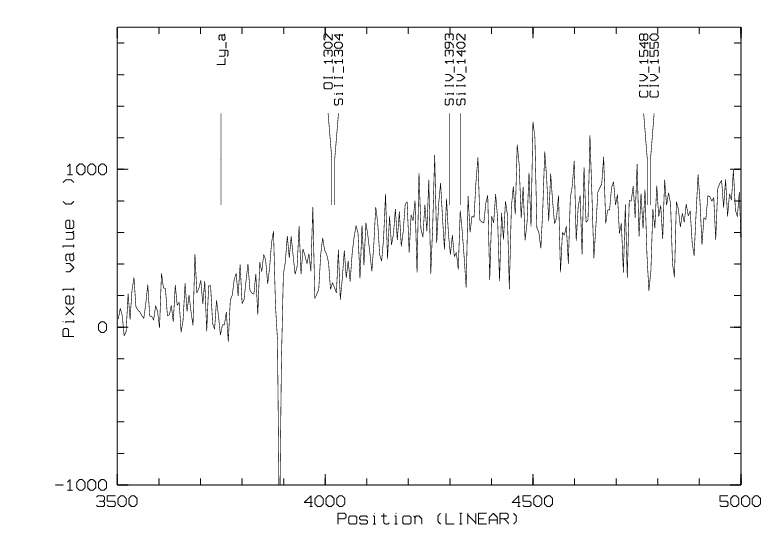
- GCN Circular #5156
S. B. Cenko and W. H. Baumgartner (Caltech) report on behalf of a larger
collaboration:
We have imaged the field of GRB060512 (Cummings et al.; GCN 5117) with the
Large Format Camera mounted on the 5-m Palomar Hale Telescope.
Observations consisted of 5 x 180 s images in the r' filter taken at a
mean epoch of May 21.25 UT. At the location of the optical afterglow, we
detect an object with approximate r' magnitude 23.7 +/- 0.2 (calculated
with respect the SDSS calibration provided by Cool et al.; GCN 5120).
If we assume limited contamination from an underlying host galaxy, the
afterglow decay remains consistent with the early-time power-law index of
0.85 (Klotz et al.; GCN 5140), indicating a late jet-break time. However,
futher observations are required to verify the host galaxy brightness.
- GCN Circular #5217
GRB 060512: Keck Redshift
J. S. Bloom, R. J. Foley, D. Koceveki, D. Perley (UC Berkeley) report:
"On 31 May 2006 UT, we observed a source consistent with the position
of the X-ray and optical afterglow of GRB 060512 (Cummings et al. GCN
5117; Mundell et al. GCN 5119) with the Keck I (+LRIS) telescope. In
a single 1200 sec spectrum we detect emission features at 5380, 7014,
7155, and 7224 Ang which we identify as [O II] 3727, H beta, and [O
III] 4959, 5007 at a redshift of z = 0.4428. The [O II] feature is
resolved as a doublet. This source is therefore is likely the host
(cf. Cenko et al. GCN 5156). This redshift confirms the hypothesis by
Piranomonte et al. (GCN 5145), that z_GRB < 2.3, would apparently
refute the claim that at z_GRB ~ 2.7 - 2.9 (Starling et al. GCN
5131). Analysis of other imaging and spectra is on going. Given the
relatively low redshift and the current time since the burst,
observations are encouraged to search for any associated supernova
which would currently be near peak brightness."
This message may be cited.
- GCN Circular #5267
D. Sharapov (MAO and NOT, La Palma), A. Djupvik (NOT, La Palma) ,
A.Pozanenko (IKI) on behalf of larger GRB follow up collaboration report:
We observed optical afterglow of GRB060512 (Cummings et al. GCN 5117;
Klotz et al. GCN 5140) in Nordic Optical Telescope with NOTcam in near IR
(J) on May 13 between (UT) 02.40 - 03:44. A brightness of the OT is
following:
J mag, Err,Exposure, T0+ (Mid time,s)
18.90 0.09 8x90s 12838
18.96 0.09 8x90s 13849
19.09 0.10 8x90s 14843
19.14 0.11 8x90s 15835
The calibration is based on 2MASS star RA = 13:02:57.846 DEC =
+41:10:23.08, J = 14.485 +/-0.03 and consistent with calibration based on IR
standard star observation in the same night. A power law decay index alpha
~ 1.1 in J between (UT) 02.40 - 03:44 (May ,13) is compatible with the
index deduced from Ks observations (Hearty et al. GCN 5126, Tanaka et al.
GCN 5129).
The first combined image of 8x90s exposure can be found in
http://grb.rssi.ru/GRB060512/grb060512_NOT_J.jpg
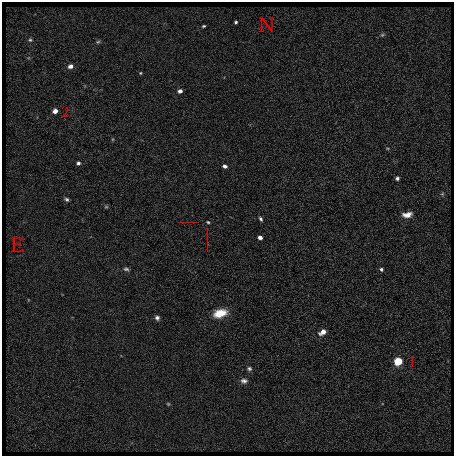
- Redshift of z = 2.1
0907.3449 from 20 Jul 2009
Fynbo et al: Low-Resolution Spectroscopy of Gamma-ray Burst Optical Afterglows: Biases in the Swift Sample and Characterization of the Absorbers
Abstract: (Abridged). We present a sample of 77 optical afterglows (OAs) of Swift detected GRBs for which spectroscopic follow-up observations have been secured. We provide linelists and equivalent widths for all detected lines redward of Ly-alpha. We discuss to what extent the current sample of Swift bursts with OA spectroscopy is a biased subsample of all Swift detected GRBs. For that purpose we define an X-ray selected sample of Swift bursts with optimal conditions for ground-based follow up from the period March 2005 to September 2008; 146 bursts fulfill our sample criteria. We derive the redshift distribution for this sample and conclude that less than 19% of Swift bursts are at z>7. We compare the high energy properties for three sub-samples of bursts in the sample: i) bursts with redshifts measured from OA spectroscopy, ii) bursts with detected OA, but no OA-based redshift, and iii) bursts with no detection of the OA. The bursts in group i) have significantly less excess X-ray absorption than bursts in the other two groups. In addition, the fraction of dark bursts is 14% in group i), 38% in group ii) and > 39% in group iii). From this we conclude that the sample of GRBs with OA spectroscopy is not representative for all Swift bursts, most likely due to a bias against the most dusty sight-lines. Finally, we characterize GRB absorption systems as a class and compare them to QSO absorption systems, in particular DLAs. On average GRB absorbers are characterized by significantly stronger EWs for HI as well as for both low and high ionization metal lines than what is seen in intervening QSO absorbers. Based on the z>2 bursts in the sample we place a 95% confidence upper limit of 7.5% on the mean escape fraction of ionizing photons from star-forming galaxies.
![]() Previous IAU Circulars
Previous IAU Circulars 








